Do-it-yourself gas column installation in an apartment: requirements and technical standards for installation
Flowing gas water heaters are a traditional attribute of the old housing facilities. This type of equipment is little known to owners of apartments in high-rise buildings with a centralized hot water supply. However, the owners of the Khrushchevs are still actively exploiting it. Not all of them know how to install a gas column in an apartment.
Agree, this question needs thorough analysis. Illiterate installation of a gas processing unit will result in a serious threat. To eliminate the slightest risks will help the information presented in our very useful article. We will familiarize you with all the subtleties and details of the installation process.
The thoroughly verified and systematized information presented by us is supported by photo collections and videos. With us you will receive complete answers to all possible questions that arise when connecting gas units.
The content of the article:
- If a gas water heater is not provided
- If the column has already been installed
- Requirements for a room with gas equipment
- Ventilation and chimney requirements
- Chimney device in an apartment with wooden walls
- Column layout rules
- Gas installation specifics
- Gas tightness test
- Analysis of the most common installation errors
- Responsibility for unauthorized installation
- Conclusions and useful video on the topic
If a gas water heater is not provided
In a house where gas equipment such as a stove is allowed, the installation of a speaker may be prohibited. This restriction applies to homes with more than 11 floors. No supervisory authority will issue a permit to install a column in such an apartment, as this is dangerous for residents.
In addition to the number of storeys, the reason for refusal may be redevelopment. Studio apartments are not suitable for the installation of gas equipment, since the devices must be installed in non-residential premises.
If the kitchen is combined with the living room, then this makes the use of gas appliances illegal. Before redevelopment, these limitations must be considered. The same can be attributed to apartments where the kitchen is absent or is common.
If the house does not fall under these restrictions, then you need to collect a package of documents for registering the device.
The procedure is as follows:
- Write a statement to the gas distribution company.
- Get a plan from BTI or Rosreestr.
- Provide an extract from Rosreestr confirming ownership.
- Contact the relevant organization to draw up the project.
- Find certified specialists from an organization that has access to gas work.
After that, specialists will make an insert into the gas pipe, connect the device and turn the water heater into operation.
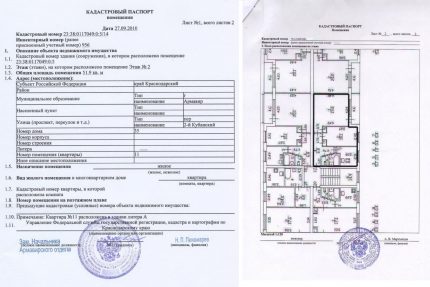
It is highly recommended that you do the installation yourself gas column bypassing the law. These actions not only lead to penalties, but also endanger the lives of people.
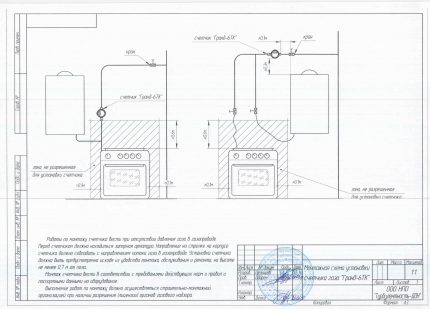
If the column has already been installed
When changing a water heater in case of a malfunction, the passport of the device must be replaced. If you independently install a geyser, then in the passport of the new device there will be no marks on commissioning and inspections.
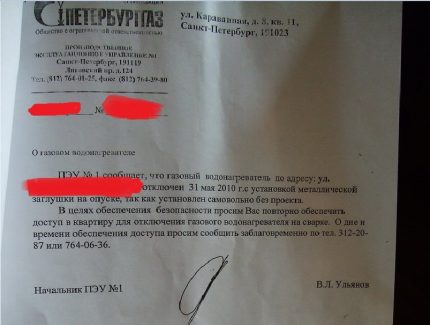
After receiving the comments, it will be necessary to reconnect the column, inviting certified specialists.
Their duties include inspection ventilation system. In old houses, they can be clogged with garbage. It is dangerous to operate clogged ventilation ducts. This can cause fatal carbon monoxide poisoning. If the decision on self-installation of the water heater is made, then first of all you need to check the ventilation.
Requirements for a room with gas equipment
The place where the gas water heater will be installed should be more than a cubic capacity of more than 7.5 m3. The height in the room should not be lower than 2.0 meters. This height according to the norms is enough for a geyser. The room must be glazed.
The window cannot be dull; it must be possible to ventilate in the event of a leak. The total glazing area (without frame) is determined by the formula:
C = O * 0.03,
Where:
C is the area of glazing.
O is the volume of air in the room.
The window must let in air for emergency ventilation. Ordinary kitchen fully comply with these requirements, if it is equipped with a door. If there is no door in the kitchen, it must be installed.
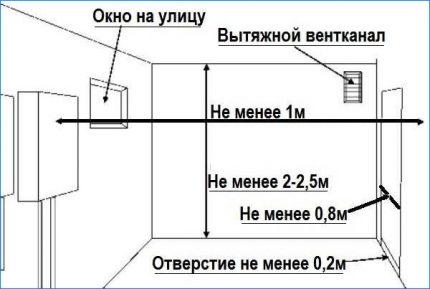
Indoor installation desired gas analyzer. It will help to detect a gas leak. This device is optional, but helps to track the operation of gas appliances. It reacts to excess propane in the air, and then warns about it with a signal.
Ventilation and chimney requirements
To create air circulation in the room, a ventilation hole is required. It should not be clogged, air should pass through it calmly. If you neglect this rule, then in the event of a gas leak, the tenants of the apartment will receive poisoning with serious consequences.
The risk of detonation of household gas will increase significantly if it is not removed naturally, since a leak can occur at night, when a person is not able to detect it.
For the normal functioning of the gas column hold a chimney. It can be displayed in a common house system or directly on the street. When constructing the chimney, it must be taken into account that it cannot have more than two bends at an angle of 90 degrees.
The total length of the chimney should not exceed three meters. Three options for the location of the chimney are allowed.

The pipe must have a vertical section at the point of connection to the water heater. The length of the vertical section must be greater than or equal to 50 cm. The length of the horizontal section of the pipe must not exceed two meters.
A chimney can be made from a flexible corrugated pipe, but it is necessary to eliminate its sagging, which can block the removal of combustion products.
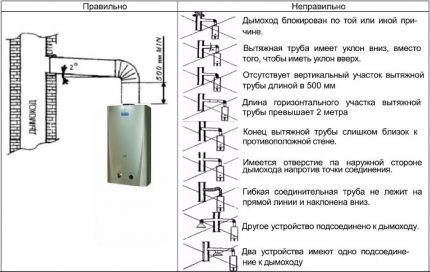
If the device of the column does not imply a chimney, then you can not be limited to the ventilation hole in the wall.It is necessary to establish a full-fledged exhaust hood, but even in this case, the gas service will have questions about a similar carbon monoxide exhaust system.
Chimney device in an apartment with wooden walls
In wooden houses, the use of a blue fuel water heater is allowed, but fire-prevention norms for installing a gas column must be observed. The chimney cannot come into contact with the tree; non-combustible material must be placed between them.
As thermal insulation, basalt or mineral wool can be used. Use of heat-resistant polyurethane foam is allowed.
This is necessary to prevent fire in case of strong heating of the chimney. As a rule, chimneys are not provided for in old wooden houses, or they are designed for stove heating. In emergency homes, the installation of gas equipment is prohibited.
Column layout rules
The water heater cannot be located on the supporting wall of the building. This is expressly prohibited by the installation requirements for gas water heaters. In the event of an explosion, this may result in damage to the building or its partial destruction.
To clarify the possibility of installing the device, you need to take information from the cadastral passport of the apartment and the general plan of the house. This information can be clarified by calling specialists.
Space requirements are presented from the column itself to the opposite wall. The distance should not be less than one meter. This is necessary for free access to the device for its maintenance and inspection. Also, pipes for supplying gas to the walls cannot be mounted.
This makes it difficult to inspect communications and search for gas leaks in the apartment. If this violation is detected, an order for elimination will be issued and information will be clarified on how to properly install the gas column and where to go.
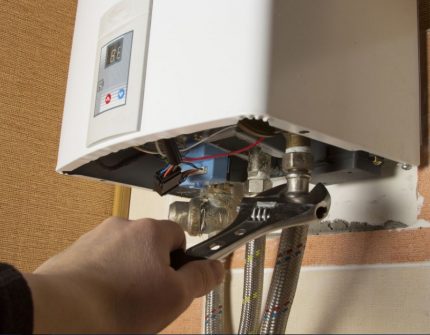
The column should be located more than 10 cm from the wall. It is not allowed to install a gas water heater on a wooden wall without prior preparation. A steel plate should be installed at the installation site, equal to or larger than the rear wall of the device.
It is not allowed to install the column above the gas stove.These devices must be at least 1 meter apart. Also can not be used cooker hood as a discharge of combustion products. Do not use a single chimney for the hood and gas column. This is expressly prohibited by safety standards.
Gas installation specifics
Pipes in the apartment are the property of its owner, but you can’t make an unauthorized change in the gas supply system. For any changes, you must obtain permission from the gas service, otherwise a fine will be issued.
If gas water heater already installed at this place, it will not cause significant changes to the project. It is enough to shut off the gas valve on the pipe and replace it. If the water heater is being installed for the first time, then you need to do the wiring.
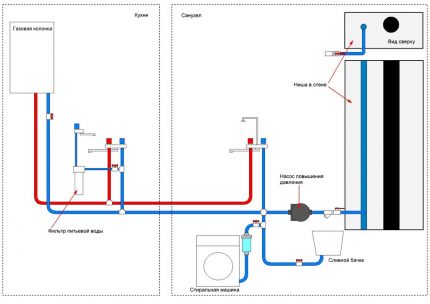
When installing pipes yourself, the following rules must be observed:
- Block the gas before starting work.
- Carry out work with an open window.
- Remove debris from pipes arising during installation.
- Do not run pipes through door and window openings.
- Do not use the ventilation shaft for pipe laying.
- Do not mount the gas pipe in the wall.
- Do not use flexible hoses longer than 3 meters.
- Paint metal pipes.
Particular attention should be paid to sealing the connecting elements of the gas pipeline. To do this, use a sealant and sealant. After completing the wiring, you can proceed to install the device.
Gas tightness test
After installing the water heater, check the gas pipes for leaks. If there is gas analyzerThis greatly simplifies the procedure and improves the quality of the check. If this device is missing, then you can use the old way.
To do this, you need ordinary soap, a jar and a brush. Soap is dissolved in a jar to the state of a liquid emulsion. Then, in succession, using a brush, the emulsion is applied to the pipe joints. As you apply, you need to monitor the appearance of bubbles in the treated areas. If they appear, it is necessary to eliminate the leak.

In no case should you check the gas leak with fire. This is dangerous and may cause an explosion. Do not risk your life and the lives of neighbors.
Gas equipment needs regular inspection and periodic cleaning. Clean column you can do it yourself, but if there is absolutely no experience in servicing such systems, it is better to contact the company that has concluded an agreement with you for the supply of gaseous fuel and the maintenance of the devices involved in this.
Analysis of the most common installation errors
The most common mistake is installing a geyser in the bathroom. In this room, as a rule, there is no window. It is especially dangerous to install speakers without a chimney.There are models of water heaters in which carbon monoxide exits through openings, and its removal from the premises occurs through an air vent in the wall.
The second most common mistake is the desire to hide the device so that it does not visually get out of the interior. Often a geyser is installed in a cabinet. This leads to a violation of the proper functioning of the gas column.
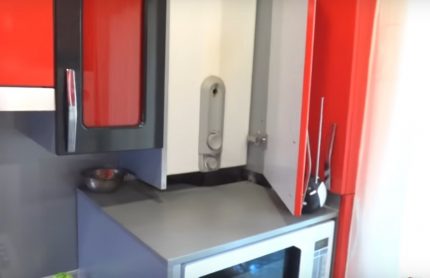
The third mistake that is often encountered is the confused connection of the gas pipe in the column. This causes water to enter the pipeline. The liquid gets there through the gas column and then moves down the pipes. So the water gets into the gas equipment of the neighbors from below, completely disabling it.
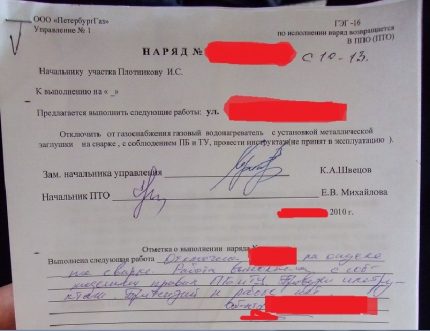
It is impossible to prevent GORGAZ employees from shutting down. In the event of a refusal, a police squad will be called in because they are in danger of human life.
Responsibility for unauthorized installation
If the insert into the pipe for connecting the column is bypassed by the meter, then such an act falls under Art. 7.19 AK of the Russian Federation. For this, administrative responsibility is provided in the form of penalties.
For individuals, fines range from one and a half to two thousand rubles. This is the smallest possible measure for illegally connecting to the gas system. The official connection to the gas centralized gas pipeline is described in detail. in the next article, which we advise you to familiarize yourself with.
In addition to the administrative code, unauthorized insertion and installation of gas equipment is subject to the Federal Law No. 69 “On Fire Safety”. According to the text of the document, the owner of the property bears administrative or criminal liability, depending on the severity of the consequences.
If the actions bring property damage to third parties, the owner will be obliged to compensate it in full. In addition, a fine of 80,000 rubles may be imposed for violation. If significant harm has been caused to the health of neighbors, the owner may be taken into custody and deprived of liberty for a term of up to two years.
Conclusions and useful video on the topic
Clip # 1. How to connect and seal pipes:
Clip # 2. What is the danger of connecting the speaker without observing fire regulations:
If it was decided to install a water heater in the apartment on your own, then it is necessary to install in accordance with all the rules. It is strictly forbidden to save on installation materials. This is the case when it is better to be safe and overpay. Otherwise, the consequences can be tragic. It is better to invite a specialist and make a payment once, than to constantly pay fines from the gas service.
Have questions about the topic of the article, find bugs or have valuable information that you want to share with other visitors to the site? Please write a comment in the box below.

 Replacement of a geyser in an apartment: replacement paperwork + basic norms and requirements
Replacement of a geyser in an apartment: replacement paperwork + basic norms and requirements 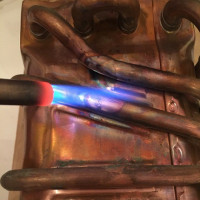 Do-it-yourself repair of a gas column heat exchanger: the main stages of soldering a copper radiator
Do-it-yourself repair of a gas column heat exchanger: the main stages of soldering a copper radiator 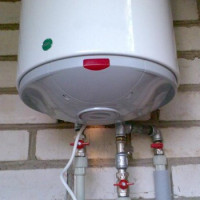 Do-it-yourself water heater installation: a step-by-step guide + technical standards
Do-it-yourself water heater installation: a step-by-step guide + technical standards 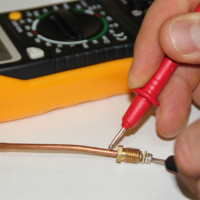 Thermocouple for a gas column: design and principle of operation + self-inspection and replacement
Thermocouple for a gas column: design and principle of operation + self-inspection and replacement 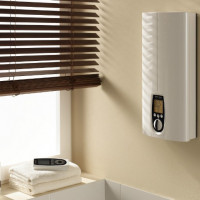 DIY instantaneous water heater installation: step-by-step instruction
DIY instantaneous water heater installation: step-by-step instruction 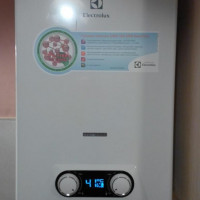 Electrolux Geyser Troubleshooting: Diagnosing Popular Breakdowns and Troubleshooting
Electrolux Geyser Troubleshooting: Diagnosing Popular Breakdowns and Troubleshooting  How much does it cost to connect gas to a private house: the price of organizing gas supply
How much does it cost to connect gas to a private house: the price of organizing gas supply  The best washing machines with dryer: model rating and customer tips
The best washing machines with dryer: model rating and customer tips  What is the color temperature of light and the nuances of choosing the temperature of the lamps to suit your needs
What is the color temperature of light and the nuances of choosing the temperature of the lamps to suit your needs
The last video (in the bathroom!) Was especially pleased, the exact opposite of what is written above!
Yes, you're right, the editor missed a bit 🙂 The video was replaced, thanks.
Installing a gas column on your own is a serious step! Safety here plays an important role, so it’s worth checking the details once again during installation. Recently, I installed the column myself and made several mistakes that could result in very serious consequences. I believe that more attention should be paid to safety.
It all depends on the mental ability of the connector. With normal, and connected and repaired, perfectly do it yourself. Without extortion engineers! Gas is not more dangerous than any other household equipment. Electricity without brains can be much more dangerous. How many cooked in the bathrooms, because they decided to heat their water with a boiler? Gas rarely fails ... it just happens to be resonant, but ... electricity annually kills much more ... ..
Wood should be mounted on iron, with an asbestos gasket, at least 3 mm thick. The fastening of the protective sheet should be outside the dimensions of the gas column. Galvanized iron is used, it can be painted with a NON-BURNABLE PAINT! Pigment of the desired color, dilute with liquid glass. I used silver. Such paint withstands temperatures up to 800 degrees and ... does not burn! She should not paint a tree - she can not stand strong fire. And a sheet of asbestos without iron cannot be used - harmful dust is formed. Therefore, after installation, the edges of the protection should be treated with liquid glass. Min.vatu, and the like, in residential premises to apply - it is IMPOSSIBLE. It is even more harmful to the lungs with dust microparticles. Better asbestos with liquid glass. Good luck to the craftsmen.
Yes, and do not forget to flush the compounds well, for quality - doesn’t it miss where the case? All connections are washed without exception! If you yourself will check your plates periodically, then you will not have any troubles! The main thing is accuracy and care.
Of course, I partially agree with you, but I, for example, am an electrician, although at the same time, with regard to gas equipment (the same column), I trust the professionals to connect. So you yourself have just described a lot of subtleties that I could not know in any way. Yes, I do not argue, you can rely on this information, plus what is found in official sources and you can connect everything yourself. But here is a slightly different situation.
So you write and ask that electricity kills more people than gas, comparing statistics. Yes, more people die from electric shock, including those who, due to lack of knowledge, decided to heat the water in the bathroom with a boiler. Gas may not be so dangerous, but it does not forgive mistakes! And if, by stupidity, only one person is killed by an electric current, then an error in installing a gas column may be worth the whole entrance!
At what distance should the outlet stand from the geyser?
Hello. We look in the joint venture 402.1325800.2018 residential buildings. Rules for the design of gas consumption systems:
“The socket for connecting gas-powered equipment must be made with a grounding contact and located in an easily accessible place within the reach of the length of the power cable of gas-powered equipment at a distance of no more than 0.5 m from the equipment itself to be able to quickly disconnect gas-powered equipment from the mains if necessary“.
The article is a complete contradiction. One of them: the distance to the stove is 1m, and in the photo they recommend 10cm.
Hello. SP 402.1325800.2018 - “the horizontal distance in the light from the protruding parts of the heating equipment to the household gas stove should be at least 10 cm“.
Thank you for the article! I wanted to ask about the chimney. We think to sew up the pipe (close it with a “box”) so that it does not visually catch the eye. Can this be done? And if so, are there any requirements?
Hello. Here here in the chapter “Communication masking methods” read.